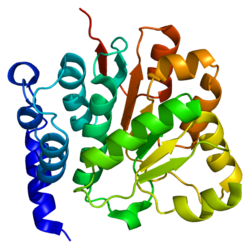Protein-coding gene in the species Homo sapiens
| DDX10 |
|---|
 |
| Available structures |
|---|
| PDB | Ortholog search: PDBe RCSB |
|---|
|
|
| Identifiers |
|---|
| Aliases | DDX10, HRH-J8, DEAD-box helicase 10, Dbp4 |
|---|
| External IDs | OMIM: 601235; MGI: 1924841; HomoloGene: 20922; GeneCards: DDX10; OMA:DDX10 - orthologs |
|---|
| Gene location (Human) |
|---|
 | | Chr. | Chromosome 11 (human)[1] |
|---|
| | Band | 11q22.3 | Start | 108,665,058 bp[1] |
|---|
| End | 108,940,999 bp[1] |
|---|
|
| Gene location (Mouse) |
|---|
 | | Chr. | Chromosome 9 (mouse)[2] |
|---|
| | Band | 9|9 A5.3 | Start | 53,009,935 bp[2] |
|---|
| End | 53,159,353 bp[2] |
|---|
|
| RNA expression pattern |
|---|
| Bgee | | Human | Mouse (ortholog) |
|---|
| Top expressed in | - sural nerve
- testicle
- Achilles tendon
- right testis
- left testis
- gonad
- ganglionic eminence
- ventricular zone
- kidney tubule
- left uterine tube
|
| | Top expressed in | - tail of embryo
- otic placode
- saccule
- genital tubercle
- Gonadal ridge
- epiblast
- primitive streak
- otic vesicle
- hair follicle
- maxillary prominence
|
| | More reference expression data |
|
|---|
| BioGPS |  | | More reference expression data |
|
|---|
|
| Gene ontology |
|---|
| Molecular function | - RNA helicase activity
- nucleotide binding
- hydrolase activity
- ATP binding
- helicase activity
- nucleic acid binding
- RNA binding
| | Cellular component | | | Biological process | - RNA secondary structure unwinding
- anterior head development
| | Sources:Amigo / QuickGO |
|
|
| Wikidata |
| View/Edit Human | View/Edit Mouse |
|
Probable ATP-dependent RNA helicase DDX10 is an enzyme that in humans is encoded by the DDX10 gene.[5][6]
DEAD box proteins, characterized by the conserved motif Asp-Glu-Ala-Asp (DEAD), are putative RNA helicases. They are implicated in a number of cellular processes involving alteration of RNA secondary structure such as translation initiation, nuclear and mitochondrial splicing, and ribosome and spliceosome assembly. Based on their distribution patterns, some members of this family are believed to be involved in embryogenesis, spermatogenesis, and cellular growth and division. This gene encodes a DEAD box protein, and it may be involved in ribosome assembly. Fusion of this gene and the nucleoporin gene, NUP98, by inversion 11 (p15q22) chromosome translocation is found in the patients with de novo or therapy-related myeloid malignancies.[6]
References
- ^ a b c GRCh38: Ensembl release 89: ENSG00000178105 – Ensembl, May 2017
- ^ a b c GRCm38: Ensembl release 89: ENSMUSG00000053289 – Ensembl, May 2017
- ^ "Human PubMed Reference:". National Center for Biotechnology Information, U.S. National Library of Medicine.
- ^ "Mouse PubMed Reference:". National Center for Biotechnology Information, U.S. National Library of Medicine.
- ^ Savitsky K, Ziv Y, Bar-Shira A, Gilad S, Tagle DA, Smith S, Uziel T, Sfez S, Nahmias J, Sartiel A, Eddy RL, Shows TB, Collins FS, Shiloh Y, Rotman G (Jan 1997). "A human gene (DDX10) encoding a putative DEAD-box RNA helicase at 11q22-q23". Genomics. 33 (2): 199–206. doi:10.1006/geno.1996.0184. PMID 8660968.
- ^ a b "Entrez Gene: DDX10 DEAD (Asp-Glu-Ala-Asp) box polypeptide 10".
Further reading
- Olsen JV, Blagoev B, Gnad F, et al. (2006). "Global, in vivo, and site-specific phosphorylation dynamics in signaling networks". Cell. 127 (3): 635–48. doi:10.1016/j.cell.2006.09.026. PMID 17081983. S2CID 7827573.
- Andersen JS, Lam YW, Leung AK, et al. (2005). "Nucleolar proteome dynamics". Nature. 433 (7021): 77–83. Bibcode:2005Natur.433...77A. doi:10.1038/nature03207. PMID 15635413. S2CID 4344740.
- Gerhard DS, Wagner L, Feingold EA, et al. (2004). "The status, quality, and expansion of the NIH full-length cDNA project: the Mammalian Gene Collection (MGC)". Genome Res. 14 (10B): 2121–7. doi:10.1101/gr.2596504. PMC 528928. PMID 15489334.
- Wang SC, Lien HC, Xia W, et al. (2004). "Binding at and transactivation of the COX-2 promoter by nuclear tyrosine kinase receptor ErbB-2". Cancer Cell. 6 (3): 251–61. doi:10.1016/j.ccr.2004.07.012. PMID 15380516.
- Strausberg RL, Feingold EA, Grouse LH, et al. (2003). "Generation and initial analysis of more than 15,000 full-length human and mouse cDNA sequences". Proc. Natl. Acad. Sci. U.S.A. 99 (26): 16899–903. Bibcode:2002PNAS...9916899M. doi:10.1073/pnas.242603899. PMC 139241. PMID 12477932.
- Andersen JS, Lyon CE, Fox AH, et al. (2002). "Directed proteomic analysis of the human nucleolus". Curr. Biol. 12 (1): 1–11. Bibcode:2002CBio...12....1A. doi:10.1016/S0960-9822(01)00650-9. PMID 11790298. S2CID 14132033.
- Nakao K, Nishino M, Takeuchi K, et al. (2000). "Fusion of the nucleoporin gene, NUP98, and the putative RNA helicase gene, DDX10, by inversion 11 (p15q22) chromosome translocation in a patient with etoposide-related myelodysplastic syndrome". Intern. Med. 39 (5): 412–5. doi:10.2169/internalmedicine.39.412. PMID 10830185.
- Zuber J, Tchernitsa OI, Hinzmann B, et al. (2000). "A genome-wide survey of RAS transformation targets". Nat. Genet. 24 (2): 144–52. doi:10.1038/72799. PMID 10655059. S2CID 21887748.
- Ikeda T, Ikeda K, Sasaki K, et al. (1999). "The inv(11)(p15q22) chromosome translocation of therapy-related myelodysplasia with NUP98-DDX10 and DDX10-NUP98 fusion transcripts". Int. J. Hematol. 69 (3): 160–4. PMID 10222653.
- Liang WQ, Clark JA, Fournier MJ (1997). "The rRNA-processing function of the yeast U14 small nucleolar RNA can be rescued by a conserved RNA helicase-like protein". Mol. Cell. Biol. 17 (7): 4124–32. doi:10.1128/mcb.17.7.4124. PMC 232266. PMID 9199348.
- Arai Y, Hosoda F, Kobayashi H, et al. (1997). "The inv(11)(p15q22) chromosome translocation of de novo and therapy-related myeloid malignancies results in fusion of the nucleoporin gene, NUP98, with the putative RNA helicase gene, DDX10". Blood. 89 (11): 3936–44. doi:10.1182/blood.V89.11.3936. PMID 9166830.
 | This article on a gene on human chromosome 11 is a stub. You can help Wikipedia by expanding it. |

 2pl3: Human DEAD-box RNA helicase DDX10, DEAD domain in complex with ADP
2pl3: Human DEAD-box RNA helicase DDX10, DEAD domain in complex with ADP

















